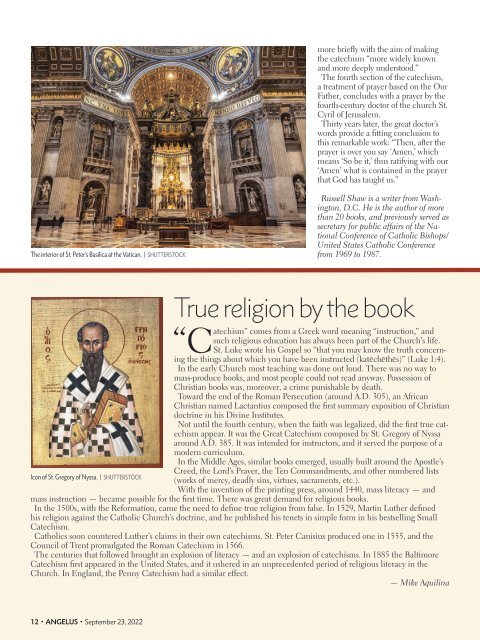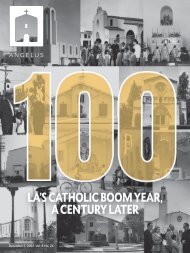Angelus News | September 23, 2022 | Vol. 7 No. 19
On the cover: The logo used for the Catechism of the Catholic Church, published in 1992, is adapted from an image found in the Catacombs of Domitilla in Rome thought to symbolize “the rest and the happiness that the soul of the departed finds in eternal life.” Ahead of the 30th anniversary of the catechism’s release next month, Russell Shaw explains on Page 10 what prompted the Church to undertake such an immense project. On Page 26, Greg Erlandson offers a perspective on the text’s relevance to ordinary Catholics — like his own mother.
On the cover: The logo used for the Catechism of the Catholic Church, published in 1992, is adapted from an image found in the Catacombs of Domitilla in Rome thought to symbolize “the rest and the happiness that the soul of the departed finds in eternal life.” Ahead of the 30th anniversary of the catechism’s release next month, Russell Shaw explains on Page 10 what prompted the Church to undertake such an immense project. On Page 26, Greg Erlandson offers a perspective on the text’s relevance to ordinary Catholics — like his own mother.
Create successful ePaper yourself
Turn your PDF publications into a flip-book with our unique Google optimized e-Paper software.
more briefly with the aim of making<br />
the catechism “more widely known<br />
and more deeply understood.”<br />
The fourth section of the catechism,<br />
a treatment of prayer based on the Our<br />
Father, concludes with a prayer by the<br />
fourth-century doctor of the church St.<br />
Cyril of Jerusalem.<br />
Thirty years later, the great doctor’s<br />
words provide a fitting conclusion to<br />
this remarkable work: “Then, after the<br />
prayer is over you say ‘Amen,’ which<br />
means ‘So be it,’ thus ratifying with our<br />
‘Amen’ what is contained in the prayer<br />
that God has taught us.”<br />
The interior of St. Peter's Basilica at the Vatican. | SHUTTERSTOCK<br />
Russell Shaw is a writer from Washington,<br />
D.C. He is the author of more<br />
than 20 books, and previously served as<br />
secretary for public affairs of the National<br />
Conference of Catholic Bishops/<br />
United States Catholic Conference<br />
from <strong>19</strong>69 to <strong>19</strong>87.<br />
True religion by the book<br />
comes from a Greek word meaning “instruction,” and<br />
such religious education has always been part of the Church’s life.<br />
“Catechism”<br />
St. Luke wrote his Gospel so “that you may know the truth concerning<br />
the things about which you have been instructed (katēchēthēs)” (Luke 1:4).<br />
In the early Church most teaching was done out loud. There was no way to<br />
mass-produce books, and most people could not read anyway. Possession of<br />
Christian books was, moreover, a crime punishable by death.<br />
Toward the end of the Roman Persecution (around A.D. 305), an African<br />
Christian named Lactantius composed the first summary exposition of Christian<br />
doctrine in his Divine Institutes.<br />
<strong>No</strong>t until the fourth century, when the faith was legalized, did the first true catechism<br />
appear. It was the Great Catechism composed by St. Gregory of Nyssa<br />
around A.D. 385. It was intended for instructors, and it served the purpose of a<br />
modern curriculum.<br />
In the Middle Ages, similar books emerged, usually built around the Apostle’s<br />
Creed, the Lord’s Prayer, the Ten Commandments, and other numbered lists<br />
Icon of St. Gregory of Nyssa. | SHUTTERSTOCK<br />
(works of mercy, deadly sins, virtues, sacraments, etc.).<br />
With the invention of the printing press, around 1440, mass literacy — and<br />
mass instruction — became possible for the first time. There was great demand for religious books.<br />
In the 1500s, with the Reformation, came the need to define true religion from false. In 1529, Martin Luther defined<br />
his religion against the Catholic Church’s doctrine, and he published his tenets in simple form in his bestselling Small<br />
Catechism.<br />
Catholics soon countered Luther’s claims in their own catechisms. St. Peter Canisius produced one in 1555, and the<br />
Council of Trent promulgated the Roman Catechism in 1566.<br />
The centuries that followed brought an explosion of literacy — and an explosion of catechisms. In 1885 the Baltimore<br />
Catechism first appeared in the United States, and it ushered in an unprecedented period of religious literacy in the<br />
Church. In England, the Penny Catechism had a similar effect.<br />
— Mike Aquilina<br />
12 • ANGELUS • <strong>September</strong> <strong>23</strong>, <strong>2022</strong>


















